Wedding Dress for Sikh Groom
- January 2, 2023
- Sikh
Well, who agrees that weddings are less than a festival? With all the preparations and
Weddings are auspicious occasions when two souls unite to spread colors and happiness in each other’s lives. They are mesmerizing not only for the couple but also for the family members. Sikh wedding rituals are full of joy and happiness.
Sikh weddings reflect the prestige they find in their culture and personal choice. They usually focus on interpersonal moments between family members and couples. Let’s learn a bit more about Sikh wedding traditions.
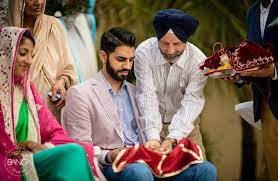
Every Indian wedding ritual begins with the consent of the parents and their blessings. The event Roka marks the union of the bride and the Groom and their families and friends. So, Roka is the very first step of the Sikh wedding, where both families meet at the bride’s home and show their approval. They exchange gifts, clothes, and sweets as a token of love.
Thaka means to set the date. In this ritual, an auspicious time and day for the wedding are fixed with the consent of both families.
Check this also Sindhi Wedding Rituals
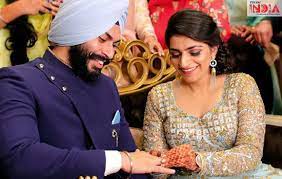
Kurmai is the engagement ceremony in the Sikh wedding. It is either held in the Groom’s house or Gurudwara in the presence of close family and friends. The ceremony starts by offering a small prayer (Adras), after which the Groom’s sisters put a palla (a wedding scarf) around the Groom’s shoulder. The bride’s father puts a handful of dry fruits into his palla, puts a kara or bangle on his wrist, and puts a Kripan (a small knife) as a symbol of the Sikh’s heroic heritage.
The bride is draped with fulkari (a decorated dupatta). Sometimes, the bride is draped with the chunni or dupatta, a family heirloom passed on from generation to generation. She is also adorned with heavy jewellery. A tiny dot of henna paste is applied on her palm to signify good luck.
The bride’s father applies tilak on the Groom’s forehead. They exchange gifts and sweets. The couple ties the knot by exchanging rings, and invitees are served food and drinks.
Check this also Marwari wedding Rituals
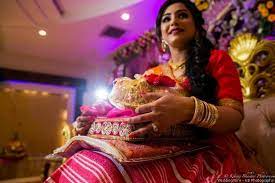
The bride’s family sends shagan, or gifts, to the Groom’s family. The shagan is presented in beautifully decorated trays and usually includes dry fruits, sweets, and clothes.
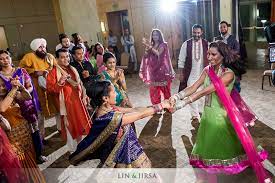
The bride’s family organises Sangeet, which is usually held at the bride’s place. It is a fun event filled with music, dance, and drums. Folk songs are sung. The bridesmaids and invitees perform dances to various songs. A few members of the Groom’s family are also invited. The bride’s family plays dholak and drums and sings songs to tease the Groom’s family. At the end of the event, dinner is served.
Check this also Muslim/Islamic Wedding Rituals
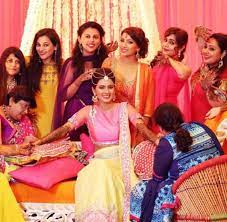
In mehendi, intricate designs of henna paste are applied to the bride’s hands and feet. The female members of the family also apply henna paste to their hands. The Groom also applies some designs to his hands. This is an all-time favourite ritual for the ladies.
Check this also Marathi Wedding Rituals
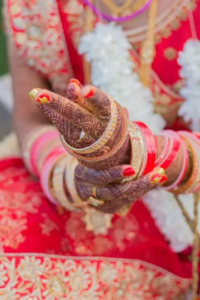
The Chooda ceremony is celebrated in the bride’s house. Chooda is a set of red bangles which the bride’s maternal uncle gifts. It is bathed with milk and rosewater. People touch chooda and give their blessings to her future married life. The bride then wears the bangles, and a cloth or shawl is wrapped around them so she can see them directly on the wedding day.
After that, the umbrella-shaped metallic ornament called kalire is tied to her hands. The bride moves her kalire over the heads of unmarried friends and relatives, and it falls on whoever is considered the next one to be married.
Check this also Tamil Wedding Rituals
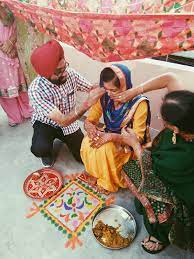
Maiya is popularly known as a cleansing ceremony. The couple applies turmeric paste to their whole body and is then seated separately at their respective homes. Traditional songs are sung, and the female members of the family hold a red cloth over the couple’s head.
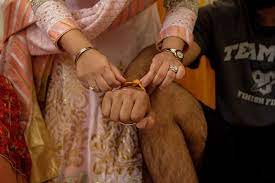
In gana, a sacred red thread is tied on the bride’s left wrist and Groom’s right wrist in a belief to bring prosperity and protection from evil throughout life.
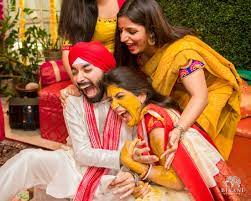
In Vatna, friends and relatives apply a paste of turmeric and mustard oil all over the bodies of the bride and Groom. This gives them a glow, and traditional songs are also sung. After this ritual, the couple is restricted from meeting each other before the wedding day.
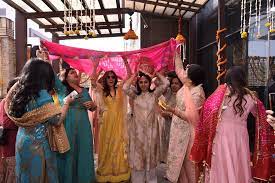
In this ritual, the bride and the Groom’s sisters-in-law bring holy water from the Gurudwara and the couple bathes.

In Django, the relatives of the bride and the Groom go to the houses of their friends and family, dancing and singing folk songs. They carry decorated pots with diyas on them. It is a loud ceremony at Sikh weddings.
Check this also Telugu Wedding Rituals
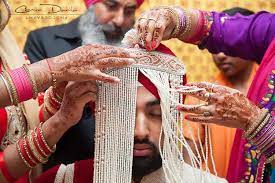
Sehra is performed at the Groom’s house. A small puja is performed. Afterwards, the Groom’s sisters and cousins tie a sehra on his head.
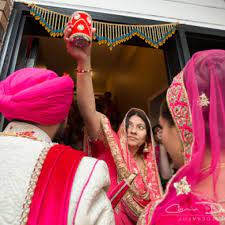
A handful of cash is waved around the bride and Groom’s heads for good luck, and surma is applied to cast away any evil energy that may surround the couple.
According to traditional Sikh aspects, jewellery and makeup are central to the wedding. However, the Sikh bride wears a heavy set of jewellery and makeup. Traditional jewellery includes mangtika, earnings, necklaces, bangles, panja, and payals. The bride wears an exquisitely embroidered Salwar Kameez set in various colours.
Nowadays, heavily embroidered lehengas are gaining popularity among Sikh brides. Though the traditional colour is red, they can go with many different colours. A dupatta with intricate designs of thread and stone is in fashion.
The traditional wedding attire for the Sikh groom is a kurta over which they wear an achkan or long coat. An achkan is made of premium fabrics like silk and is heavily embellished. Nowadays, grooms choose sherwanis with intensive embroidery and threadwork as their wedding attire. The achkan or sherwani is paired with a Churidar Pyjama and footwear called jooti. He wears a turban or headgear on his head and decorates himself with a sword on one side, which is famous in Punjab destination weddings.
Read more about wedding dresses for Sikh grooms.
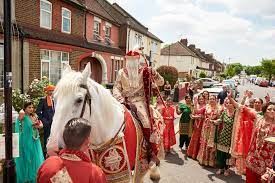
The Groom, dressed in his wedding attire, and his invitees proceed towards the gurdwara, where the bride’s family greets them. This is the exciting part for both families, who are about to unite. The baraat dances and sings along the way to the venue.
Check this also Gujrati Wedding Rituals
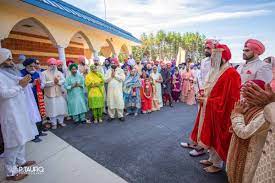
Milni is the formal introduction of family members of both sides, followed by the exchange of garlands and a small photo session.
Check this also: The Manipuri Wedding Rituals
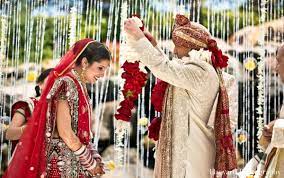
Jaimals is a beautifully made garland of flowers. The couple exchanges these garlands, marking the beginning of the journey of divine love. Later on, the guests of both families tease each other and enjoy the wedding.
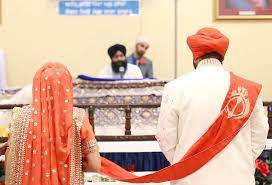
Anand Karaj, the leading wedding event, celebrates the family’s union and the couple’s love. To begin this event, the priest enchants the holy book, Guru Granth Sahib. Meanwhile, all the guests, the bride and the groom, are seated. Kirtans, the song recitations of shabads, are sung. After this, the bride’s father performs the palla rasam, taking one end of the Groom’s palla and giving it to his daughter to hold.
Check this also Kashmiri Rituals Muslim Wedding
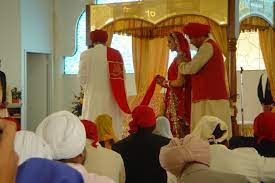
Laavans are the marriage hymns and the most essential part of the ceremony as they unite the couple through religious prayers. The Ragis, or Sikh musicians, recite four caravans. On every caravan, the couple rounds around the Guru Granth Sahib, with the Groom holding his Kirpan (sword) and leading the bride. This is called pheras. It is done in front of the sacred fire.
The vows are taken on each pheras to seal their marriage union. Once the couple completes the pheras, the Groom applies sindoor to the bride’s hair partition and puts a beaded necklace, i.e., mangalsutra, around the bride’s neck. After that, they take the blessings of the older family members by touching their feet.
Karah prasad, a ceremonial sweet, is distributed among the guests. A fun tradition called joota chupai is also performed, in which the bride’s sister and cousins steal the Groom’s footwear and demand money to return it to him.
Check this also Kashmiri Rituals Hindu Pandit Weddings
In the end, the lavish feast is served in the langar hall. The bride and the Groom eat for the first time as husband and wife.
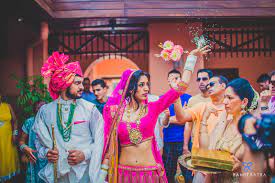
Vidai is the bride’s departure from her parental house. She bids her family and friends goodbye and conveys her love and good wishes to them by throwing a handful of puffed rice over her head. This is an emotional moment for the bride and her family members. Her brothers and cousins escort her to her husband, who is waiting to take her to their new home.
Check this also Wedding rituals in Bihar
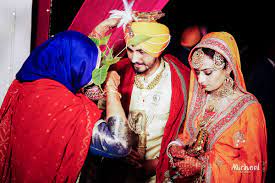
The newlyweds are welcomed at the Groom’s house by his mother. This ritual celebrates the couple and blesses them for their new journey.
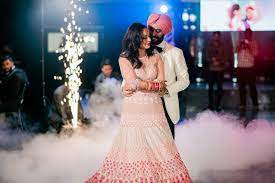
The Groom’s side organizes a grand celebration with a lavish feast. Friends and family members are invited, and some fun games are played to add fun to the celebration.
After the reception, the newlyweds visit the bride’s parents. In this ritual, the bride’s brother usually escorts them.
Also, read about Punjabi / Sikh Wedding Dates 2024.